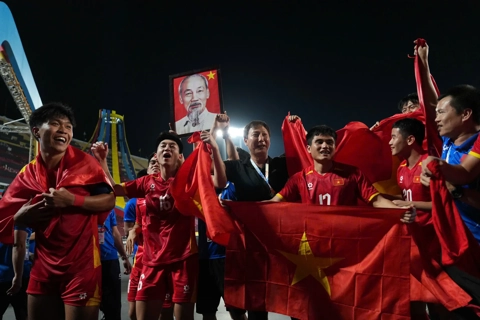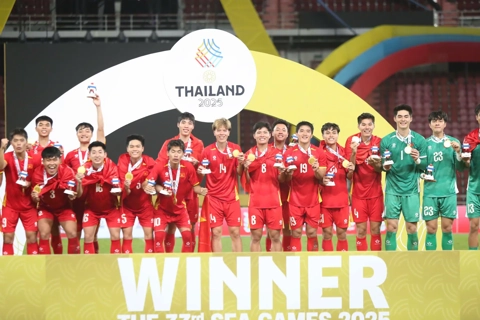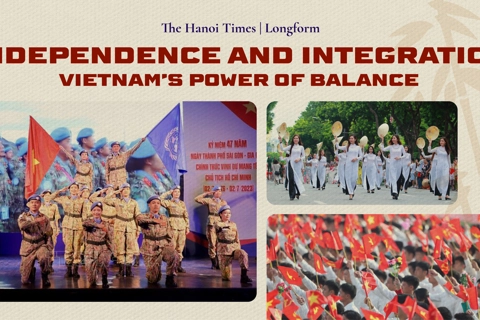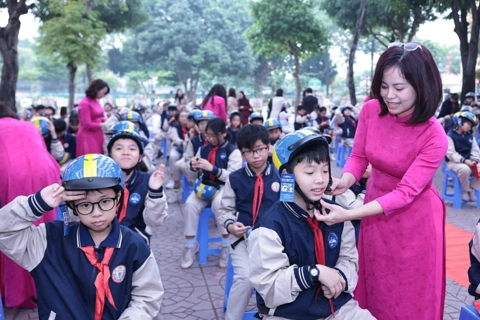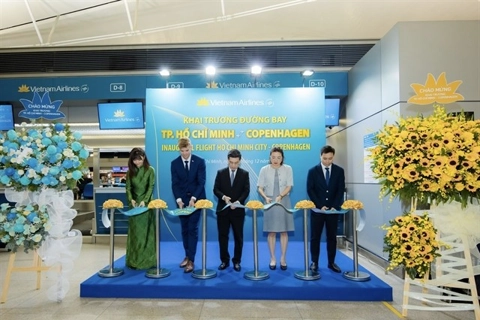Vietnam
Just the beginning
Mar 20, 2018 / 04:13 PM
The much-anticipated visit by the USS Carl Vinson to Da Nang in March turned a new page in bilateral ties between Vietnam and the US.
Reminders of the American War linger in Hanoi.
The wreckage of a B52 in Huu Tiep Lake is one such reminder for Nguyen Ngoc Thao, who has lived in Ngoc Ha village for all his 83 years. “It was shot down by Vietnam’s air defense shortly before the war against the US ended,” he said. “People aged 20 to 40 hardly know anything of the war, as it was such a long time ago. Vietnam and the US are now friends.”
The arrival of the USS Carl Vinson in Vietnam in March proves that the friendship is indeed thriving.
After docking at Tien Sa Port in Da Nang on March 5, the aircraft carrier drew large crowds of local people and worldwide attention. “Historic” was how the visit was described by Time magazine, the BBC and The Telegraph newspaper, while CNBC called it a “landmark visit”.
Analysts believe the visit expresses the Trump administration’s willingness to reinforce cooperation with Vietnam and its commitment in the region. “It’s about increased strategic trust,” said Professor Carlyle Thayer from Australian Defense Force Academy. “Vietnam has been reassured by the Trump administration that it will enhance the comprehensive partnership.”
The trip could have even taken place earlier, according to Murray Hiebert, Senior Adviser and Deputy Director South East Asia of the Center for Strategic and International Studies (CSIS). “Washington was ready to send an aircraft carrier to Vietnam several years ago,” Hiebert told Hanoitimes.
Meanwhile, Major General Le Van Cuong, former Head of the Public Security Strategic Institute (PSSI) at the Ministry of Public Security, believes that the visit can be viewed as proof of more practical and effective US-Vietnam ties. “This is how a bilateral relationship works,” he said.
Layers of messaging
The site of the visit - Da Nang - is heavy with symbolism. The city witnessed the arrival of US troops in 1965 and their departure in 1973; a milestone towards the war ending two years later.
Nearly 50 years have now passed, and the arrival of a US aircraft carrier holds different meaning. The sailors, during their stay, visited a shelter for people suffering from the effects of Agent Orange.
The US will soon finish a five-year, US$110 million program designed to clean soil contaminated by Agent Orange around Da Nang International Airport. Such acts, among others, reflect a change in course for both countries, from ex-foes to friends.
The visit also comes amid rising tensions in the region over China’s aggressive territorial expansion in the East Sea. “It suggests that the US, under the Trump administration, plans to remain active in the East Sea and support countries that face pressure from an increasingly assertive China,” said Hiebert.
Another message, according to Professor Thayer, is that the US will maintain its naval presence in the East Sea and that Vietnam supports the presence of the US Navy for regional peace and stability. “The visit is a tangible demonstration that the US under the Trump administration will remain engaged in maintaining the balance of power in Southeast Asia,” he said.
Chinese response
China feeling “uncomfortable” about the visit, experts believe, is an overreaction. “So far China has acted with restraint, voicing no official objections to the visit by the USS Carl Vinson,” Professor Thayer said.
Vietnamese analysts insist that the visit isn’t aimed at threatening any country and believe any negative reaction could damage China’s credibility internationally. “China has chosen to be silent and that’s wise,” said Major General Cuong.
In the current climate, the aircraft carrier’s arrival actually contributes to peace and stability in the region. “In principle, Vietnam supports actions that are in line with international law on freedom of navigation,” said the 72-year-old Major General. “It doesn’t matter whether such actions annoy China or not.”
Mr. Hiebert said that China previously described the visit as routine and suggested it wouldn’t protest. After all, US aircraft carriers also visit Hong Kong. “Does China respond by asking for a visit by its aircraft carrier?,” he asked. “Does Vietnam hold back in cooperation with the US out of concern that China will think Hanoi is moving too quickly with Washington? We’ll have to see.”
Just the beginning
The US Navy band impressed Da Nang residents with a rendition of a song from famous Vietnamese composer the late Trinh Cong Son, entitled “Noi vong tay lon”, about national unity and which was popular during the war. This was reminiscent of former President Barack Obama’s speech during his trip to Vietnam two years ago, when he said that Trinh Cong Son’s music is a bridge between Vietnamese and Americans.
Numerous cooperation commitments, including on defense, made between Vietnam and the US under the Obama administration remain and are expanding. The visit by the USS Carl Vinson is another brick in the wall of the relationship.
Defense ties will grow following the visit. “The US will help Vietnam upgrade its technology and capability,” said Hiebert. “Another area of cooperation may be training and equipping Vietnam’s coast guard.”
Observers also believe the visit will pave the way for future visits by other US aircraft carriers and navy vessels as well as interaction between US military personnel and their Vietnamese counterparts. “It represents a gradual expansion in relations,” suggested Professor Thayer. “Vietnam and the US have already conducted naval engagement activities but not joint military exercises.”
For both countries to take advantage of the success of the visit, one thing they will need to do, according to Hiebert, is explore ways to continue other naval cooperation through joint naval exercises and other visits. This visit represented a means for both countries to dig deeper into the partnership. “It sets the scene for other visits by warships, destroyers and even submarines,” Major General Cuong said. “This is just the beginning.”
The wreckage of a B52 in Huu Tiep Lake is one such reminder for Nguyen Ngoc Thao, who has lived in Ngoc Ha village for all his 83 years. “It was shot down by Vietnam’s air defense shortly before the war against the US ended,” he said. “People aged 20 to 40 hardly know anything of the war, as it was such a long time ago. Vietnam and the US are now friends.”
The arrival of the USS Carl Vinson in Vietnam in March proves that the friendship is indeed thriving.

Aircraft carrier USS Carl Vinson arrived in Da Nang this March
|
Analysts believe the visit expresses the Trump administration’s willingness to reinforce cooperation with Vietnam and its commitment in the region. “It’s about increased strategic trust,” said Professor Carlyle Thayer from Australian Defense Force Academy. “Vietnam has been reassured by the Trump administration that it will enhance the comprehensive partnership.”
The trip could have even taken place earlier, according to Murray Hiebert, Senior Adviser and Deputy Director South East Asia of the Center for Strategic and International Studies (CSIS). “Washington was ready to send an aircraft carrier to Vietnam several years ago,” Hiebert told Hanoitimes.
Meanwhile, Major General Le Van Cuong, former Head of the Public Security Strategic Institute (PSSI) at the Ministry of Public Security, believes that the visit can be viewed as proof of more practical and effective US-Vietnam ties. “This is how a bilateral relationship works,” he said.
Layers of messaging
The site of the visit - Da Nang - is heavy with symbolism. The city witnessed the arrival of US troops in 1965 and their departure in 1973; a milestone towards the war ending two years later.

Inside the carrier
|
Nearly 50 years have now passed, and the arrival of a US aircraft carrier holds different meaning. The sailors, during their stay, visited a shelter for people suffering from the effects of Agent Orange.
The US will soon finish a five-year, US$110 million program designed to clean soil contaminated by Agent Orange around Da Nang International Airport. Such acts, among others, reflect a change in course for both countries, from ex-foes to friends.
The visit also comes amid rising tensions in the region over China’s aggressive territorial expansion in the East Sea. “It suggests that the US, under the Trump administration, plans to remain active in the East Sea and support countries that face pressure from an increasingly assertive China,” said Hiebert.
Another message, according to Professor Thayer, is that the US will maintain its naval presence in the East Sea and that Vietnam supports the presence of the US Navy for regional peace and stability. “The visit is a tangible demonstration that the US under the Trump administration will remain engaged in maintaining the balance of power in Southeast Asia,” he said.
Chinese response
China feeling “uncomfortable” about the visit, experts believe, is an overreaction. “So far China has acted with restraint, voicing no official objections to the visit by the USS Carl Vinson,” Professor Thayer said.

Zoom in the aircraft carrier during its visit to Vietnam on March
|
In the current climate, the aircraft carrier’s arrival actually contributes to peace and stability in the region. “In principle, Vietnam supports actions that are in line with international law on freedom of navigation,” said the 72-year-old Major General. “It doesn’t matter whether such actions annoy China or not.”
Mr. Hiebert said that China previously described the visit as routine and suggested it wouldn’t protest. After all, US aircraft carriers also visit Hong Kong. “Does China respond by asking for a visit by its aircraft carrier?,” he asked. “Does Vietnam hold back in cooperation with the US out of concern that China will think Hanoi is moving too quickly with Washington? We’ll have to see.”
Just the beginning
The US Navy band impressed Da Nang residents with a rendition of a song from famous Vietnamese composer the late Trinh Cong Son, entitled “Noi vong tay lon”, about national unity and which was popular during the war. This was reminiscent of former President Barack Obama’s speech during his trip to Vietnam two years ago, when he said that Trinh Cong Son’s music is a bridge between Vietnamese and Americans.

The USS Carl Vinson leaves Tien Sa port, Da Nang
|
Defense ties will grow following the visit. “The US will help Vietnam upgrade its technology and capability,” said Hiebert. “Another area of cooperation may be training and equipping Vietnam’s coast guard.”
Observers also believe the visit will pave the way for future visits by other US aircraft carriers and navy vessels as well as interaction between US military personnel and their Vietnamese counterparts. “It represents a gradual expansion in relations,” suggested Professor Thayer. “Vietnam and the US have already conducted naval engagement activities but not joint military exercises.”
For both countries to take advantage of the success of the visit, one thing they will need to do, according to Hiebert, is explore ways to continue other naval cooperation through joint naval exercises and other visits. This visit represented a means for both countries to dig deeper into the partnership. “It sets the scene for other visits by warships, destroyers and even submarines,” Major General Cuong said. “This is just the beginning.”

